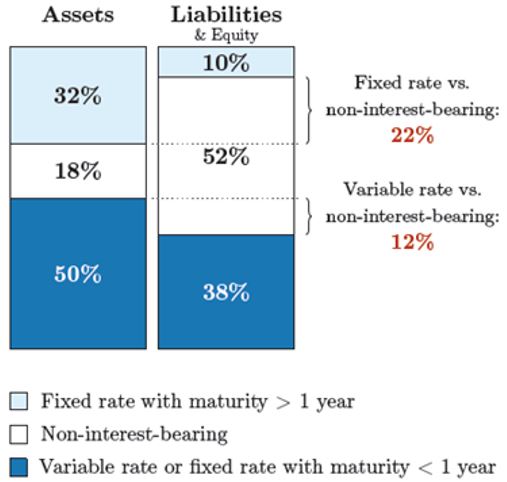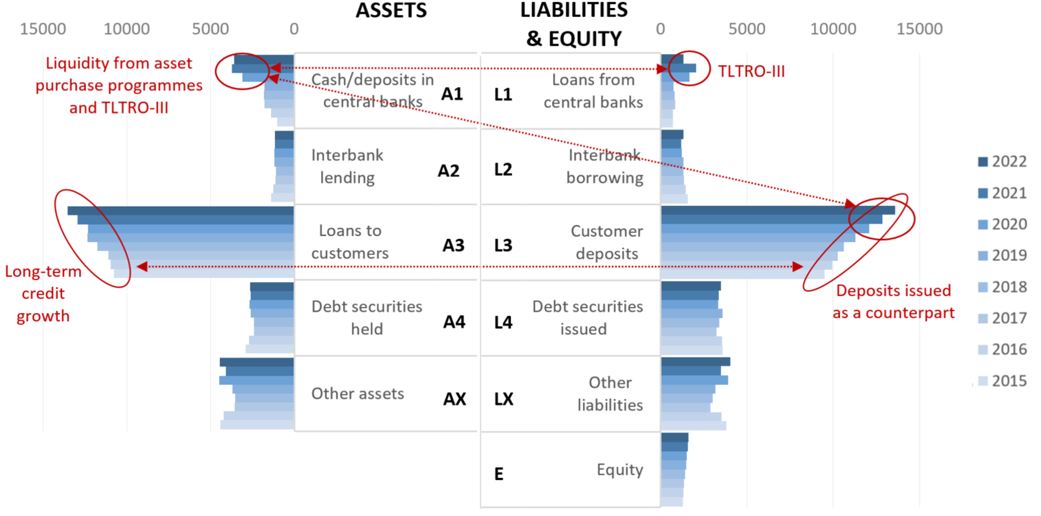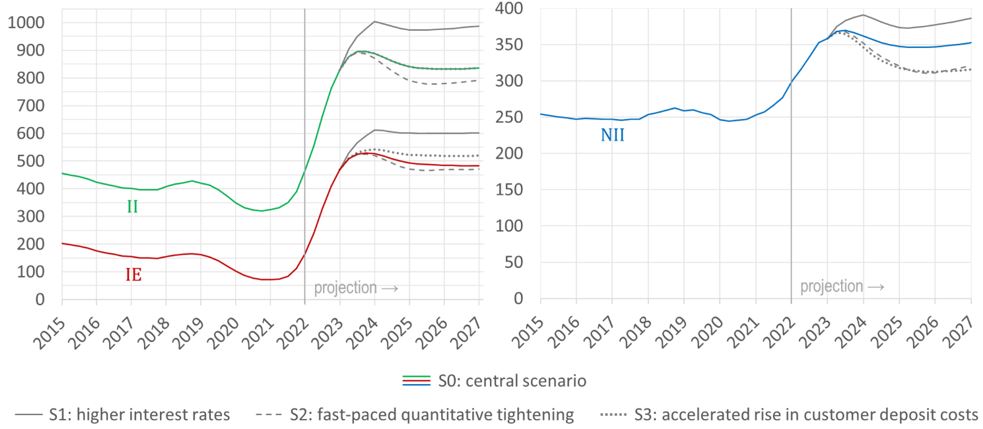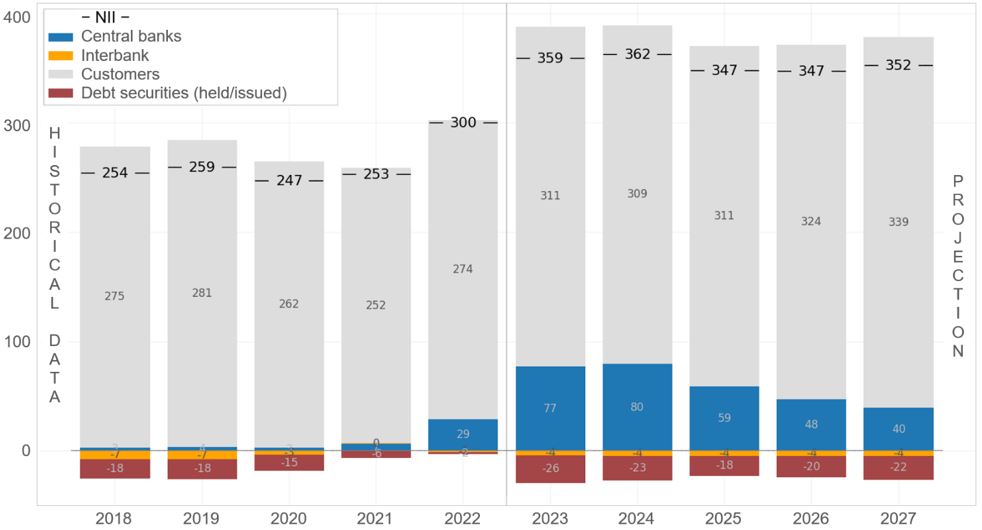

Disclaimer: This brief summarises the findings from a model (“MAP”) discussed in detail in Banque de France Working Paper No. 931, by the same authors. The views expressed are those of the authors and do not necessarily reflect the position of the Banque de France.
We explore the evolution of euro area banks’ net interest income (NII) in the context of higher interest rates. At the end of 2022, their aggregate balance sheet features a net surplus of interest-paying assets compared to liabilities, both on the long term and on the short term. Such a structure, which can be traced back to recent unconventional monetary policies, yields higher NII under rising interest rates. This is corroborated by an explicit projection of future NII values by an ALM model, which simulates balance sheet evolution using double-entry accounting principles. It confirms that the current positive trend of aggregate NII for the euro area banking sector is linked to rising rates, and quantifies the NII sensitivity to other risk factors, such as central bank operations on securities and changes in the cost structure of customer deposits.
Banks’ profitability depends to a large extent on their ability to collect more interests on their assets than they pay on their liabilities. The resulting net interest income (NII) must be large enough to enable banks to absorb losses and to accumulate capital through retained earnings. In the present context of volatile interest rates, the variability of banks’ NII is a key question for financial stability. We explore it here on an aggregate basis for the euro area banking sector, first qualitatively, by comparing their asset structure with their liability structure in terms of interest rate regimes and maturities, then quantitatively, using an ALM-like model to explicitly project the future evolution of their aggregate NII under various scenarios.
The traditional representation of banks’ balance sheets is that they are engaged in a maturity transformation business, i.e. they borrow short-term and lend long-term. Specifically, on the assets side, banks typically feature a significant proportion of fixed-rate instruments with relatively long maturities (mainly customer loans and securities). The interest income from such products is highly inertial to interest rate fluctuations. On the liabilities side, on the other hand, long-term fixed rates are much rarer and the interest-bearing resources are largely at rates that can be revised periodically: these are mainly savings accounts and short-term deposits. In such a situation, the reaction of interest expense (on the liabilities side) to a change in interest rates should therefore be more immediate than that of interest income (on the assets side), hence the generally accepted view that the banks’ net interest income tends to decline when interest rates go up.
Gathering information from several supervisory data sources, it is possible to reconstruct the aggregate balance sheet structure of the euro area banks considered as “significant institutions”, as it stood when euro interest rates began their hike to check the accuracy of this presumption. Figure 1 represents the aggregate balance sheet as of the end of 2022 in the form of an asset-liability match to provide a clearer picture of the breakdown between the different interest rate regimes. As expected, fixed-rate assets (in light blue) are larger than fixed-rate liabilities; however, variable-rate assets (in dark blue) also make up a larger proportion of the balance sheet than variable-rate liabilities. This balance sheet structure is therefore different from the traditional picture: in addition to a surplus of fixed-rate assets, banks have a surplus of variable-rate assets, both of which are backed by non-interest-bearing liabilities. Hence, on closer examination, the sensitivity of the NII to changes in interest rates is expected to be rather positive at the end of 2022.
Figure 1: Simplified structure of the aggregate balance sheet of euro area banks as of end-2022 (25 trillion euros)

Note: Sum of the consolidated balance sheets of all euro area’s Significant Institutions as designated by the EU supervisors, accounting for abt. 85% of the euro area’s total banking assets. Deposits on the liability side are split between the variable-rate and the non-interest-bearing part according to their estimated sensitivity to prevailing interest rates.
Sources: SSM supervisory data – authors’ calculations.
The large surplus of variable-rate assets observed on the balance sheet of banks at the end of 2022 is the sum of individual bank positions which can be very different and stem from various commercial and risk-management strategies. However, accounting identities impose constraints on the aggregate position, which can therefore be explained in part by the developments in the monetary policy in previous years. In particular, two effects have contributed to making banks net receivers of variable rates:
The evolution of euro area banks’ balance sheet over the period 2015-2022 (see Figure 2) illustrates the former effect: from 2020 onwards, deposits on the liabilities side (L3) increase more strongly than loans on the assets side (A3), which corresponds to the strong inflow of liquidity from central banks (A1) due to the securities purchase programmes.
Figure 2: Evolution of the aggregate balance sheet of euro area banks, 2015-2022

Note: Sum of the consolidated balance sheets of all euro area’s Significant Institutions as designated by the EU supervisors.
Sources: SSM supervisory data – authors’ calculations.
Given the evolution of banks’ balance sheets, the future evolution of their NII cannot be inferred from past behaviour: even if a robust relationship can be identified between banks’ NII and the level of interest rates in past data, the recent changes in the balance sheet structure mean that such relationships may not hold any longer. In addition, the fast pace of the 2022–23 interest rate hikes has few recent precedents which could be used to infer the short- and long-term effects on net interest income.
This makes the case for a financial approach to bank NII modelling, along the lines of the asset-liability management models used internally by banks. The idea is to explicitly track the amounts in the various parts of the banks’ balance sheet as well as the average interest rates they yield, and to jointly project the future evolution of these quantities in a consistent way under a given scenario. The future NII is then obtained by summing and netting the interests paid by both sides of the balance sheet.
The MAP (Modèle Actif-Passif), developed at Banque de France, is an example of such a model. Designed at the level of the aggregate euro area banking system, it follows a double-entry accounting logic and leverages the near-closed-system properties of the banking sector to generate fully consistent projections of its balance sheet: the overall volume of customer deposits follows from the settlement of loans, securities and other accounts, and the effect of central bank transactions is explicitly modelled. The average interest rates evolution results from the effect of the expiration of existing assets and liabilities and their replacement with new ones, taking into account maturity schedules and the split between fixed- and variable-rate products. This model is detailed in Gentil, Ray & Toader (Banque de France Working Paper No. 931, December 2023).
To keep assumptions at a minimum, the MAP allows for a large number of degrees of freedom regarding scenario design. Amongst the main financial variables in input are interest rates levels, the total volume of loans to customers, the cost structure of customer deposits, and the volume of assets held by central banks in non-conventional monetary policy context. No assumption is made on the relationship between these variables, so that any combination in their future evolution over a 5-year horizon can be tested: the model translates it into banks’ future balance sheet amounts and quarterly net interest income.
The long-term effects of the 2022–23 interest rate hike on banks’ NII can be projected by setting up the MAP on the end-2022 aggregate balance sheet as shown above, enriched with information on maturities, fixed- vs. variable rate split, initial average interest rate values and other relevant information for each aggregated account. Then a 5-year scenario can be applied: the scenario presented in the above-mentioned Working Paper features the observed continued rise in euro short-term interest rates in 2023, followed by a plateau and a progressive easing in 2025. The other main scenario features are a stagnation of the volume of loans, a sharp rise in the share of interest-paying deposits, and a progressive decline of the Eurosystem’s portfolio of securities.
In this example scenario, as displayed in figure 3 (“S0: central scenario”), the model projects a large upward shift in both interest income and expense in 2023, followed by a relative stability or even decline. With income moving faster than expense, the net effect on NII is projected to be clearly positive, shooting above 350 billion euros in 2023 and 2024 up from 253 billion in 2021. This can be understood in terms of the balance sheet analysis presented above: the variable-rate and short-maturity assets and liabilities produce interests that rise with the short-term rate, and the excess of assets in this category makes the net effect positive. On the longer term, this benefit tends to erode under the joint effect of deposit migration to higher-remuneration products and of the absorption of central bank reserves resulting from the end of the unconventional monetary policy. However, these negative effects are balanced out by the increasing interest rate paid by long-term assets as they progressively incorporate more profitable products, leading to a stable overall NII on the long term.
Figure 3: Projected 5-year evolution of the aggregate NII of euro area banks in a sample of scenarios

Note: Annual revenues and costs over 4 rolling quarters. II: Interest income. IE: Interest expense. NII: Net interest income. Numbers up to 2022 are computed by summing euro area Significant Institutions’ financial statements. Numbers starting 2023 are projected using the MAP in various scenarios.
Sources: SSM supervisory data, authors’ computations.
The durable rise in the aggregate net interest income of euro area banks projected by the model in this example scenario does not mean that the current environment is devoid of interest rate risks. Running the model on alternative scenarios (figure 3 scenarios S1, S2 and S3) makes it possible to identify circumstances which could adversely affect banks’ revenues.
The positive sensitivity of bank NII to the level of interest rates, already identified, means that scenarios where policy interest rates are cut, or where long-term market rates decline, are less favourable, with a sensitivity of about 30 billion euros of yearly NII per percentage point of interest rate levels applied as a parallel shock (scenario S1), all other variables being held equal.
Another source of risk is linked to the banks’ net position with the central banks, driven by the evolution of the central bank asset portfolios: in an extreme scenario (S2) where the Eurosystem’s quantitative tightening were to accelerate with a complete liquidation at the end of 2025, the banks would get lower deposits and lower excess reserves as a consequence of the repayments to the central banks, thereby losing a source of net interest income worth 30 billion euros per year.
Finally, the banks’ NII is sensitive to the cost of their deposit base. With more than 12 trillion euros in customer deposits, their interest expense would raise by 1 billion euros per year for every basis point of increase in the average interest rate paid on deposits of all forms, all else being held equal. In scenario S3, a repricing of +30 basis points of the interest served to overnight deposits, combined with a shift of 8% of them towards term deposits, results in 30 billion euros in additional yearly interest expense.
These risks are not exhaustive; in particular, given the importance of customer loans and deposits in the formation of net interest income, a decline in the stock of loans, leading mechanically to lower deposit volumes, is also quite negative, with a sensitivity of around 5 billion euros of yearly NII for every percentage point of loan volume.
All these risks are, to the first order, symmetrical, with opposite moves producing extra profits in NII; they are also by nature interdependent, with lower interest rate levels yielding lower NII sensitivity to volumes and deposit cost structure.
In addition to projecting the overall NII and its sensitivities, the analytical procedure produces a whole set of intermediate variable, including balance sheet amounts and average interest rates for each balance sheet item. In particular, it allows a decomposition of the projected interest fluctuations in the four main categories of bank operations, cf. figure 4: this shows the predominance of customer-facing positions in the formation of bank NII, but also the key role played by banks’ reserve holdings at central banks in its current evolution.
Figure 4: Breakdown of the aggregate NII of the euro area banking sector, by counterparty (annual values, billion euros)

Note: Annual net interest income (NII). Numbers up to 2022 are computed by summing euro area Significant Institutions’ financial statements. Numbers starting 2023 are projected using the MAP in the “central scenario” (S0).
Sources: SSM supervisory data, authors’ computations.
As all models, the MAP relies on a set of assumptions, which may in some cases prove wrong and lead to erroneous projections. A back-testing process is in place to check that the model, run from past starting points with observed values of rates and other variables, accounts for the past and current levels of net interest income. So far, this exercise gives robust results for euro area banks; any future deviation can be analysed and traced back to a model assumption.
The model’s robustness is largely due to the choice of modelling the banking system at the aggregate level, which makes it insensitive to many behaviour-dependent events such as payments between non-bank economic agents. In particular, the modelled evolution of deposits is a mechanical result from the behaviour of the central bank, the other central bank depositors, and from the volume of loans and securities. No “aggregate bank run” can happen in practice since deposits leaving one bank always end up in another bank. This aggregate perspective has a flip side: the model does not provide any individual perspective. Although the euro area banking sector’s aggregate NII has a positive reaction to rising interest rates, this may hide considerable disparity between individual credit institutions. Such a model is designed to be used as a macro monitoring tool, rather than from a micro perspective.
Finally, while the model is tailor-made for the present situation of euro area banks, it is modular in nature and could accommodate, with adequate adaptations, a different banking sector – a national version already exists for the French banking sector. It can also be enhanced to explore the consequences in terms of aggregate balance sheet and interest flows of potential future changes in the financial system, such as the issuance of central bank digital currencies.